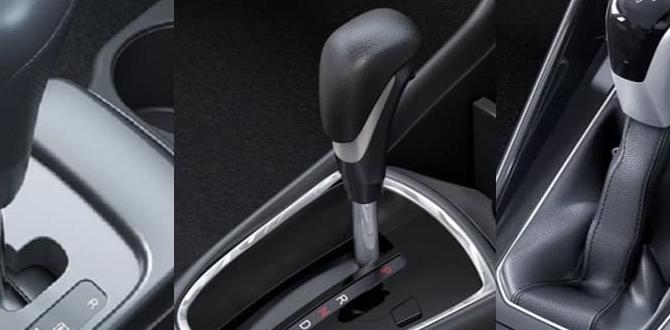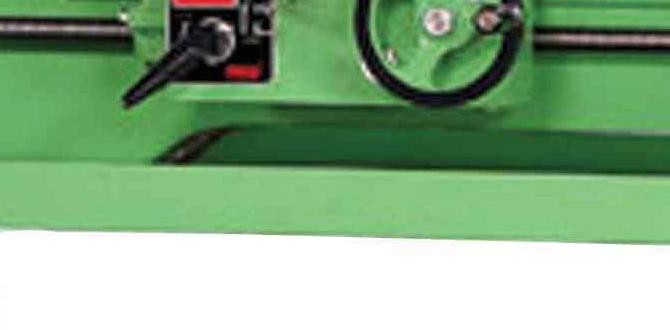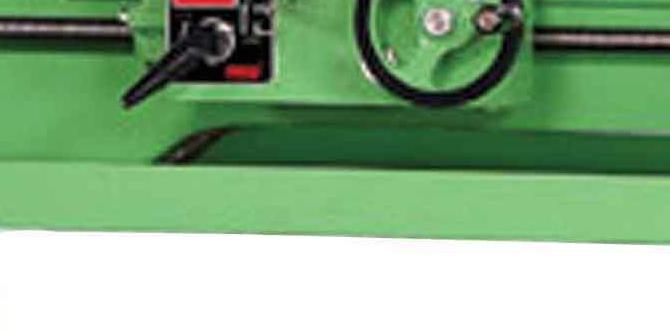In short, understanding wood lathe tool steel grades like High-Speed Steel (HSS) and its common variants (M2, M42) is key to achieving clean cuts, extending tool life, and ensuring a safer, more enjoyable woodworking experience. Choosing the right steel for your lathe tools makes a huge difference.
Hey there, fellow woodturners! Daniel Bates here from Lathe Hub. Ever stood in front of a shelf packed with wood lathe tools, wondering what makes one chisel slice through oak like butter while another seems to gum up the works? It’s a question that trips up a lot of beginners, and honestly, it can be frustrating. The secret often lies not just in the tool’s shape, but in the very metal it’s made from – the steel grade. Don’t worry, though! We’re going to break down this whole “steel grade” mystery in a way that’s simple and makes perfect sense. By the end of this guide, you’ll know exactly what you’re looking for and why it matters.
Why Different Steel Grades Matter for Your Wood Lathe Tools
Think of your lathe tools like a chef’s knives. You wouldn’t want to chop vegetables with a butter knife, right? Each job requires a specific tool made from the right material. For woodturning, the material is steel, and not all steel is created equal. The grade of steel dictates how well a tool can hold an edge, how resistant it is to heat, and how easily it can be sharpened. These factors directly impact the quality of your turns, the effort you need to put in, and how often you have to stop to resharpen. For beginners, understanding this is like discovering a cheat code for smoother, more satisfying woodworking.
The Basics: What is Tool Steel?
Tool steel is a type of carbon alloy steel that is particularly suitable for making tools. Its key characteristics include hardness, toughness, wear resistance, and the ability to withstand high temperatures without losing its effectiveness. When we talk about tool steel for wood lathes, we’re generally referring to steels that can be hardened and tempered to achieve these desirable properties. The specific composition of the steel, particularly the addition of elements like tungsten, molybdenum, cobalt, and vanadium, gives each grade its unique strengths.
High-Speed Steel (HSS): The Workhorse of Woodturning
When you’re looking at wood lathe tools, the most common and highly recommended material you’ll encounter is High-Speed Steel, or HSS. This isn’t just a fancy name; it refers to a steel alloy that can maintain its hardness and cutting ability even when subjected to high temperatures generated by fast cutting speeds. This is crucial in woodturning, where friction can quickly turn a sharp edge dull.
HSS was a revolution when it was developed, allowing for much faster machining speeds than previously possible. For woodturners, this translates to:
- Improved Edge Retention: HSS tools stay sharper for longer periods, meaning fewer interruptions for resharpening.
- Heat Resistance: They can handle the heat generated by aggressive cutting without softening and losing their edge.
- Versatility: HSS is suitable for a wide range of woods, from soft pine to hard maple and exotics.
- Ease of Sharpening (relatively): While harder than simple carbon steel, HSS is still very manageable on standard sharpening systems.
Most beginner and intermediate wood lathe tools are made from various grades of HSS. Understanding the specific HSS grades can help you make informed purchasing decisions and appreciate the differences in performance.
Common HSS Grades Explained
Not all HSS is the same. The “speed” in High-Speed Steel comes from its alloying elements. Different combinations and percentages of these elements create different grades of HSS, each with slightly different properties. For woodturners, the most important distinction usually involves the presence of cobalt and molybdenum.
M2 HSS: The Standard for Quality Tools
M2 is often considered the benchmark for good quality HSS woodturning tools. It offers an excellent balance of hardness, toughness, and wear resistance. It’s a tungsten-molybdenum high-speed steel and is a very popular choice for tool manufacturers due to its reliable performance and cost-effectiveness.
Key characteristics of M2 HSS:
- Good overall hardness.
- Excellent toughness, making it less prone to chipping than some harder steels.
- Good wear resistance.
- Relatively easy to sharpen compared to higher alloyed steels.
- A great all-around performer for most woodturning tasks.
If a tool is simply labeled “HSS” and it’s from a reputable brand, it’s very likely to be M2 or a similar grade. It’s a fantastic starting point for any woodturner.
M42 HSS: The Cobalt Powerhouse
When you need a tool that can handle denser woods, takes aggressive cuts, or simply needs to hold an edge for an exceptionally long time between sharpenings, M42 HSS is a step up. M42 is an 8% cobalt high-speed steel. The addition of cobalt significantly increases the steel’s red hardness and wear resistance.
Key characteristics of M42 HSS:
- Superior Red Hardness: It stays hard at higher temperatures than M2, meaning it can be pushed harder and faster.
- Exceptional Wear Resistance: It will hold a sharp edge for considerably longer than M2, especially when working with abrasive woods.
- Increased Toughness (with proper heat treatment): Despite its hardness, M42 can be very tough when manufactured correctly.
- Harder to Sharpen: The increased hardness and alloying elements mean M42 requires more effort and the right abrasives (like diamond wheels or specific ceramic stones) to sharpen effectively.
“Cobalt” tools are often made from M42. While they can be more expensive and harder to sharpen, the extended performance is often worth it for serious turners, especially those working with difficult materials or doing production turning. You can learn more about different steel compositions and their properties from resources like MatWeb’s comprehensive material property database, which details various metal grades.
Other HSS Variants
While M2 and M42 are the most common for woodturning tools, you might occasionally see other HSS grades. These often have minor variations in tungsten, molybdenum, cobalt, vanadium, and chromium content, fine-tuning the balance of hardness, toughness, and wear resistance. For a beginner, focusing on the distinction between general HSS (likely M2) and “Cobalt” (likely M42) is usually sufficient.
The Importance of Heat Treatment
It’s not just the steel’s composition that matters; how it’s treated during manufacturing is equally critical. Heat treatment involves carefully heating and cooling the steel to achieve its desired hardness and toughness. A well-heat-treated tool will perform as expected, while a poorly treated one might be brittle, not hold an edge, or fail prematurely.
Manufacturers of quality tools invest heavily in precise heat treatment processes. This ensures that the HSS reaches its full potential. For you as a woodturner, this means that while two tools might be made of the same grade of steel, one from a premium brand might outperform a cheaper alternative simply due to superior heat treatment.
Beyond HSS: When Might You See Other Steels?
While HSS dominates the woodturning tool market, a few other steel types might appear, though they are less common for primary cutting tools you’d find in a beginner’s kit.
Carbon Steel
Older tools or very inexpensive beginner sets might be made of carbon steel. Carbon steel tools can be very sharp and are easier to sharpen than HSS. However, they have significant drawbacks for most woodturning:
- Poor Heat Resistance: They lose their temper (hardness) very quickly when heated, meaning edge retention is poor, and they dull rapidly.
- Prone to Rust: Carbon steel is generally more susceptible to rust than stainless or HSS.
Because of their limitations, carbon steel tools are generally not recommended for regular wood lathe use, especially for beginners who need tools that perform reliably without constant adjustment.
Carbide Inserts
These aren’t a steel grade but a different cutting material entirely. Carbide inserts are small, very hard tips (often made of tungsten carbide) that are brazed or screwed onto typically metal shanks. They offer:
- Extreme Hardness and Wear Resistance: They stay sharp for a very long time.
- No Sharpening Required (of the insert): When the edge dulls, you simply rotate to a new side or replace the insert.
- Can be Brittle: They can chip or break if subjected to shock or lateral force.
- Different Cutting Action: Often used for scraping rather than traditional shearing cuts, requiring a different technique.
Many modern “easy-turn” or “detail” tools use carbide inserts. They are excellent for certain tasks and materials but represent a different approach to woodturning than traditional HSS gouges and chisels. Many woodworkers discuss the pros and cons of different tool types on forums like those found at Wood Treasures Forums, offering practical insights.
Choosing the Right Tool: Matching Steel to Your Needs
As a beginner, you don’t need to overcomplicate things. Start with good quality HSS tools. Here’s a simple breakdown:
For General Use and Beginners
- Focus on: Tools clearly labeled as M2 HSS or good quality “HSS.”
- Why: They offer a superb blend of performance, durability, and ease of use. They are forgiving and will serve you well as you learn and develop your skills.
- What to expect: Good edge retention, ease of sharpening on common sharpening systems, and reliable performance across various wood types.
For Demanding Use or Increased Longevity
- Focus on: Tools labeled as M42 HSS or “Cobalt” HSS.
- Why: If you frequently turn very hard or abrasive woods (like lignum vitae or some exotics), or if you want tools that hold an edge significantly longer between sharpenings, M42 is a great investment.
- Considerations: Be prepared for more effort during sharpening. Ensure your sharpening system can handle harder steels effectively.
Sharpening: The Underrated Skill
No matter how good the steel, a dull tool will ruin your work. Learning to sharpen your wood lathe tools effectively is as important as understanding the steel they’re made from. Here’s what you need to know generally:
- Grinding Wheels: Often made of aluminum oxide or silicon carbide. For HSS, aim for slower-speed grinders to minimize heat buildup. A 60-80 grit wheel is good for shaping, and a 120-180 grit wheel for honing. For M42, a diamond grinding wheel is often recommended for efficiency and to avoid overheating.
- Sharpening Stones: Water stones, oil stones, and ceramic stones can all be used. Finer grits (1000 and up) are used for honing and achieving a razor-sharp edge. For M42, diamond plates are excellent for both grinding and sharpening.
- Honing: After grinding, a few light passes on a fine stone or a leather strop with honing compound will bring the edge to its peak sharpness.
Always try to maintain the original bevel angle of the tool. Sharpening too aggressively or ineffectively can ruin the heat treatment near the edge, making the tool perform poorly. Wood Magazine offers great visual guides for sharpening techniques.
Tool Maintenance and Care
Proper care extends the life of your tools, regardless of their steel grade.
- Clean After Use: Wipe down tools to remove wood dust and resin, which can be abrasive or corrosive.
- Store Properly: Keep tools organized in a way that prevents the edges from banging against each other. A tool rack or cabinet is ideal.
- Rust Prevention: For carbon steel or tools you don’t use frequently, a light coat of paste wax or a specialized tool protectant can prevent rust. High-quality HSS is less prone to rust, but it’s still good practice.
- Avoid Striking: Never hit your lathe chisels with a hammer. Use them as intended.
- Inspect Regularly: Before each use, quickly check your tools for any nicks or damage to the edge.
Frequently Asked Questions (FAQ)
What is the best steel for wood lathe tools?
For most wood turners, especially beginners, High-Speed Steel (HSS) is the best choice. It offers a great balance of hardness, toughness, wear resistance, and heat resistance. M2 HSS is a very common and reliable grade.
Should I buy HSS or Cobalt tools?
If you’re just starting, good quality HSS (like M2) is perfectly fine and more economical. If you frequently work with very hard or abrasive woods, or want tools that hold an edge for much longer, M42 (Cobalt) HSS is worth the investment, but it requires more effort to sharpen.
How do I know if my wood lathe tool is good quality?
Look for tools from reputable manufacturers that clearly state the steel grade (e.g., M2 HSS, M42 HSS). Tools that are simply labeled “steel” or “high carbon steel” are generally of lower quality and will not perform as well.
Can cheap wood lathe tools be made of good steel?
While it’s possible, it’s less common. Very cheap tools often compromise on steel quality, heat treatment, or both. It’s usually better to invest in fewer, higher-quality HSS tools than many cheap ones that will dull quickly and be frustrating to use.
What is “red hardness” in tool steel?
“Red hardness” refers to a steel’s ability to retain its hardness at high temperatures. HSS, especially grades like M42 with cobalt, has excellent red hardness, meaning it can cut effectively even when the tool edge gets very hot from friction.
How often should I sharpen my wood lathe tools?
This depends heavily on the type of wood, the aggressiveness of your cuts, and the quality of the steel and its heat treatment. Sharpen your tools whenever you notice them starting to “drag” or require more force to make a cut. For HSS, this might be every 15-30 minutes of heavy use, while M42 might last much longer. Always check the edge; a sharp tool is safe and effective.
Can I sharpen M42 steel with a regular grinder?
While you can technically grind M42 with standard aluminum oxide wheels, it’s very inefficient and risks overheating the edge, which can ruin the heat treatment. Diamond grinding wheels are highly recommended for M42 as they are much harder, cut efficiently, and generate less heat, preserving the steel’s temper.
Conclusion
Navigating the world of wood lathe tool steel grades might seem daunting at first, but understanding the basics of High-Speed Steel (HSS), particularly the common M2 and M42 variants, is a powerful step in your woodworking journey. It’s not about having the most exotic steel, but about choosing tools that are well-made from appropriate materials for the job. For the vast majority of woodturners, especially those just starting out, opting





